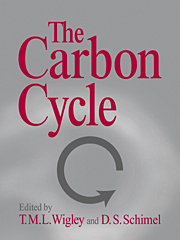Book contents
- Frontmatter
- Contents
- Preface
- Acknowledgments
- Contributors to the 1993 Global Change Institute
- I INTRODUCTION
- II THE MISSING CARBON SINK
- III PALEO-CO2 VARIATIONS
- IV MODELING CO2 CHANGES
- 14 Future Fossil Fuel Carbon Emissions without Policy Intervention: A Review
- 15 The Future Role of Reforestation in Reducing Buildup of Atmospheric CO2
- 16 Simple Ocean Carbon Cycle Models
- 17 Very High Resolution Estimates of Global Ocean Circulation, Suitable for Carbon Cycle Modeling
- 18 Effects of Ocean Circulation Change on Atmospheric CO2
- 19 Box Models of the Terrestrial Biosphere
- 20 Impacts of Climate and CO2 on the Terrestrial Carbon Cycle
- 21 Stabilization of CO2 Concentration Levels
- Part V Appendixes
- Index
21 - Stabilization of CO2 Concentration Levels
from IV - MODELING CO2 CHANGES
Published online by Cambridge University Press: 04 December 2009
- Frontmatter
- Contents
- Preface
- Acknowledgments
- Contributors to the 1993 Global Change Institute
- I INTRODUCTION
- II THE MISSING CARBON SINK
- III PALEO-CO2 VARIATIONS
- IV MODELING CO2 CHANGES
- 14 Future Fossil Fuel Carbon Emissions without Policy Intervention: A Review
- 15 The Future Role of Reforestation in Reducing Buildup of Atmospheric CO2
- 16 Simple Ocean Carbon Cycle Models
- 17 Very High Resolution Estimates of Global Ocean Circulation, Suitable for Carbon Cycle Modeling
- 18 Effects of Ocean Circulation Change on Atmospheric CO2
- 19 Box Models of the Terrestrial Biosphere
- 20 Impacts of Climate and CO2 on the Terrestrial Carbon Cycle
- 21 Stabilization of CO2 Concentration Levels
- Part V Appendixes
- Index
Summary
Abstract
The various CO2 concentration stabilization profiles used in Intergovernmental Panel on Climate Change (IPCC) analyses are described, and their methods of construction explained. Padé approximant coefficients are given to allow readers to recalculate the profiles precisely. Forward and inverse initialization strategies are discussed, and industrial emissions requirements for the “S” and “WRE” profiles are compared and evaluated. Details of the post-1990 carbon budget breakdown for the specific case of WRE550 are given. Uncertainties in the industrial emissions required for stabilization following any given profile are quantified. Uncertainties considered are those resulting from the effects of: CO2 fertilization formulation (logarithmic versus rectangular hyperbolic); the prescribed future “history” of net deforestation; terrestrial sink specification and the IPCC restriction of this sink to CO2 fertilization only; and ocean flux uncertainties. Sink specification is the greatest source of uncertainty, leading to potential errors in implied emissions of up to ±2 Gt C/yr for WRE550. Errors of this magnitude are equivalent to a misspecification of the stabilization level of approximately ±50 ppmv.
Introduction
The stabilization of future atmospheric CO2 concentration is one of the primary aims of the United Nations Framework Convention on Climate Change (UNFCCC). Article 2 of this convention gives the following objective: “To achieve stabilization of greenhouse gas concentrations … at a level that would prevent dangerous anthropogenic interference with the climate system….”
- Type
- Chapter
- Information
- The Carbon Cycle , pp. 258 - 276Publisher: Cambridge University PressPrint publication year: 2000
- 9
- Cited by



